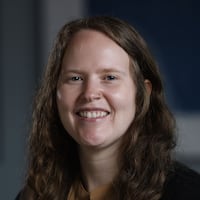Clark State College, celebrating its 60th anniversary this year, has taken significant steps in recent years to contribute to the revitalization efforts by adding courses and program to keep up with the demand.
“Clark State will continue to offer strong transfer and workforce programs to ensure that students can attain family-sustaining wages and thrive in our region,” said President Jo Alice Blondin.
Greater Springfield Partnership President and CEO Mike McDorman said job attraction in the future could also include remote workers.
“Talent attraction in the future will not only include attracting people to the jobs we have, but it may be attraction of remote workers. We’re building this quality of life, we spend a lot of time putting this quality of life together and we think it’s going to be pretty unique and pretty special in the next few years,” he said.
Clark State is also focused on military and veterans, and how they can best serve that population of learners since they are close to Wright Patterson Air Force Base and Springfield Air National Guard, Blondin said.
As for the future, Blondin said the college hopes to play a significant training role in many programs, such as the Mobility and EVTOL program developments at the Springfield Airport, and strive to be a place for the diverse communities they serve.
When it comes to aerospace, Greater Springfield Partnership Vice President of Economic Development Horton Hobbs said they have a good chance to leverage that opportunity.
“We have a real opportunity as a community to leverage our unique ability of interacting with the companies that are testing here, as the only places they can test to try to understand what their workforce needs are going to be as they grow and as they launch,” he said. “We’ve already begun that work of working closely with many involved in the agility prime (a program seeking to create and speed a commercial market for advanced air mobility aircraft), but also with our local school systems to understand how they can adapt and how they can support that industry.”
Wittenberg University will also continue to help students with workforce needs through its strategic planning work.
“In pursuing these options and in remaining true to its mission and purpose, Wittenberg will not only meet current and future student needs but exceed them as it firmly positions itself to continue to deliver a life-changing education,” said President Michael Frandsen.
The city and county will continue to deliver a pipeline of employees not only through higher education institutions, but also with the help of GISA and its potential growth and expansion.
The governing board is considering the expansion of the academy’s program to include more pathways to support the work taking place in the region with Advanced Air Mobility (AAM), said Founding Director Joshua Jennings. The initial plans would be to introduce AAM themes throughout the programming that will support the agriculture pathway.
“Including AAM as part of our focus creates a variety of additional opportunities and possibilities that will not only serve our students, but the community as it works to support the workforce needs of an emerging industry,” he said.
The board is also pursuing a facility project and program expansion on Clark State’s campus that will focus on an “Upper Academy” that will serve grades 10-12. Jennings added that moving these grades off the current school site will create opportunity for other expansions.
“This will provide expanded opportunities in additional career pathways related to the emerging workforce development needs of our local community and region, such as Aerospace and Aviation Technology,” Jennings said.
When it comes to keeping employers and employees in the future, Hobbs said their retention strategy has always been central to their efforts, which is in coordination with the city, county, Clark State, Department of Job and Family Services and other partners.
“It’s (retention) always been 82% of our job growth,” he said. “When we go out and we meet with our companies, we’re asking, are you hiring, are you investing, do you have training needs, do you have space needs, and then we’re assembling the team to respond to that.”
There are multiple job types that fit multiple industry sectors, Hobbs said, and they’re working with companies to see where there are similarities in need across industry types and then developing workforce strategies to support that.
Hobbs said they will continue to work with colleges and universities to help equip students entering the workforce with the right skills and tools. He said being close to Interstate 70 for employees to commute to work in Dayton, Columbus, other areas, and vice versa, also helps with that.
“We have a much larger pool of potential employees to draw from, and we just demonstrate it by industry. That makes Springfield a really strong play for the regional assets (for other cities),” he said. “That sets us up for sustainable growth moving forward.”
About the Author

